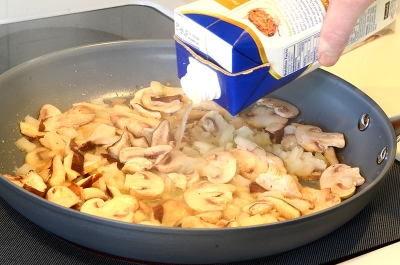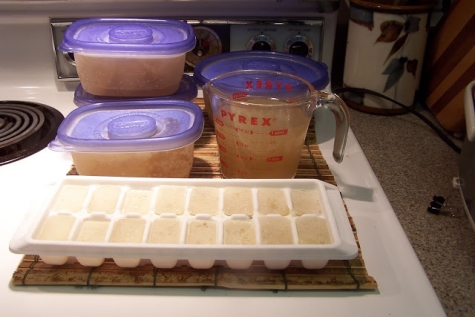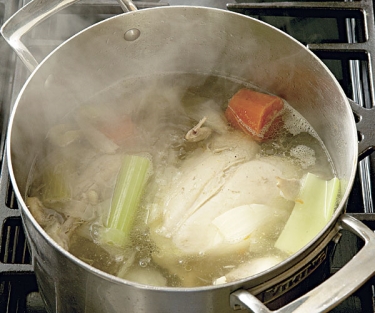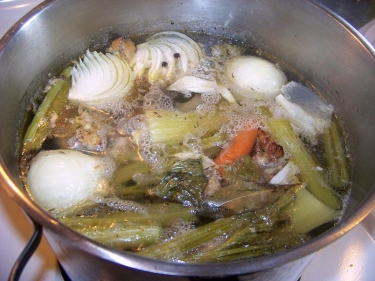Stock and Broth Differences
By Alice Osborne
Have you noticed how many holiday recipes tend to call for chicken or beef broth or stock (gravies, stuffings, soups, aspics, mashed potatoes, etc.)? It got me to wondering "What's the difference between the two?"
Well, stock and broth are very similar: water simmered with meat and/or bones, and usually some vegetables and aromatic herbs, then strained. (Though in the case of vegetable broth, meat is not used.) They're both used as the base for soups, sauces, and gravies. And, some chefs use the words interchangeably. However, there are some differences between stock and broth that you'll be glad to know:
Professional chefs and culinary instructors all agree on the differences: "Stock is predominantly made with bones and some trim." Broth, on the other hand, is usually made with pieces of actual meat, so it's much richer in taste and texture. It tastes more like a finished product that can be served on its own.
And here's something good to know: You can fortify stock with more meat to make broth.
 For practical purposes, if you're making a recipe that calls for stock, you can use broth, and vice versa. If you're not making your own stock or broth, you can find canned or boxed broth at most grocery stores. (Stock is not widely available.) You can use this for any recipe that calls for stock, too, but try to buy the low-sodium version, because store-bought broth is usually overly salty.
For practical purposes, if you're making a recipe that calls for stock, you can use broth, and vice versa. If you're not making your own stock or broth, you can find canned or boxed broth at most grocery stores. (Stock is not widely available.) You can use this for any recipe that calls for stock, too, but try to buy the low-sodium version, because store-bought broth is usually overly salty.
I personally prefer boxed broths. They come in aseptic packaging that doesn't need refrigeration until the box is opened. Then the stock can be stored in the refrigerator for 2 weeks. For longer storage, freeze the stock in ice cube trays, then package the cubes in zippered freezer bags for up to a year. I always look for the brand with the fewest ingredients—the real stuff tends to cost a little more, but I'm OK with that since I'm not crazy about adding fillers, preservatives, and other mystery ingredients to our food.
Packaged stocks and broths tend to have a little excess fat that you may want to remove before using. You can remove it refrigerating the package before opening. Then, whether the stock is in a box or a can, the fat will be a solid disc on top of the broth. Simply remove and discard the fat, then use the product.
A couple things to know when using a packaged product: Each 14 ounce can of broth or stock contains 1-3/4 cups of liquid. Each 32 ounce asceptic box contains 4 cups of liquid.
Now some great uses for either stock or broth (taken from "Busy Cooks" on about.com):
- Use chicken, beef, or vegetable broth to cook rice. The rice will have a marvelous flavor, and will be more tender than rice cooked with plain water.
- Cook couscous and hydrate cracked wheat with broths or stocks. Again, this adds so much flavor and not too many calories.
- Stocks and broths can be used to reheat leftover stir-fries. Use a small amount over high heat, and add the leftover food; quickly and gently stir-fry until heated.
- You can 'saute' in stocks or broths instead of oil. Use the same amount of liquid as oil the recipe calls for. Watch the food carefully, though, because the stock evaporates while the oil doesn't-it's easy to overcook or burn when not using oil.
- Baste chicken, beef, or pork while it's roasting in the oven with broths or stocks to add more flavor and to keep the meat moist.
- Moisten leftover casseroles with a few spoonfuls of broth and stock before reheating in the oven, in the microwave, or on the stovetop.
- Bouillon cubes can be used to make chicken, beef, or vegetable stock. I'm not pro-cubes—they're high in sodium and I don't think they taste as good; they have an after-taste that doesn't contribute one good thing to a recipe. But there are reviews where home economists like the cubes better than canned stocks. Trust your own judgment and taste buds!

HOT TIP: You can make your own stocks and broths and freeze them in ice cube trays just like you do the purchased varieties:

Homemade Chicken Or Turkey Borth

While this is a little time-consuming (prep time: 25 minutes, cook time: 4 hours, 30 minutes, and total time: 4 hours, 55 minutes), the results are worth it—affordable real and wholesome food!
Serving size: 15
Calories per serving: 14
2 pounds chicken or turkey backs, necks, and wings
8 cups water
2 onions, quartered
1 carrot, chopped
2 celery stalks, with leaves, chopped
2 tablespoons chopped parsley
1 teaspoon salt
1/4 teaspoon pepper
Directions:
Remove bones, strain broth, and check for seasonings. Cool uncovered in the refrigerator, then skim fat. This broth will store in the fridge for 3 days, or frozen for 6 months.
Recipe formatted with the Cook'n Recipe Software from DVO Enterprises.
Homemade Chicken Or Turkey Borth

While this is a little time-consuming (prep time: 25 minutes, cook time: 4 hours, 30 minutes, and total time: 4 hours, 55 minutes), the results are worth it—affordable real and wholesome food!
Serving size: 15
Calories per serving: 14
2 pounds chicken or turkey backs, necks, and wings
8 cups water
2 onions, quartered
1 carrot, chopped
2 celery stalks, with leaves, chopped
2 tablespoons chopped parsley
1 teaspoon salt
1/4 teaspoon pepper
Directions:
Remove bones, strain broth, and check for seasonings. Cool uncovered in the refrigerator, then skim fat. This broth will store in the fridge for 3 days, or frozen for 6 months.
Recipe formatted with the Cook'n Recipe Software from DVO Enterprises.
- www.packworld.com
- www.gardenwalkgardentalk.com
- www.onparadisecove.blogspot.com
- www.finecooking.com
- www.creatingnaturally.com

Alice Osborne
Weekly Newsletter Contributer since 2006


